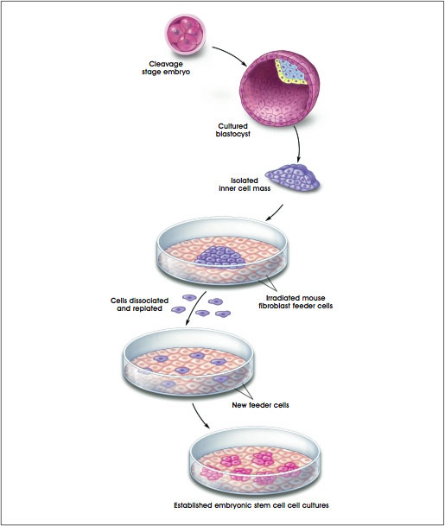When scientists work on cutting-edge research to ultimately contribute to the most benefit of humanity, they need the most advanced tools and the most advanced techniques to be efficient and effective at the same time. The field of stem cell research is no different. What are the tools and techniques stem cell biologists and biomedical researchers use? Learn about them here.
Growing Human Embryonic Stem Cells The pluripotency of Human embryonic stem cells, or hESCs, makes them essential and versatile tools for scientists who study stem cell biology. So, how do scientists derive and grow hESCs? First, cells from the inner cell mass of a human blastocyst are cultured. The blastocyst is usually derived from an in vitro fertilization (IVF) embryo, and is always obtained with full donor and legal consent. The pluripotent cells of the inner cell mass are separated from the surrounding trophectoderm by immunosurgery, the antibody-mediated dissolution of the trophectoderm. The inner cell masses are plated in culture dishes containing a growth medium supplemented with fetal bovine serum on feeder layers of mouse embryonic fibroblasts that have been gamma-irradiated to prevent their replication. After about 15 days, when the inner cell masses have divided and formed clumps of cells, cells from the periphery of the clumps are chemically or mechanically dissociated and re-plated in the same culture conditions. Colonies of cells that appear to be homogeneous are selectively removed, mechanically dissociated, and re-plated. These are then expanded and passaged, thereby creating a hESC line. Lines can be further expanded to generate even more lines. Lines can be preserved for a relatively long time.
The video on the right, made by the Australian Stem Cell Center, shows how hESCs are created. (Video Citation 6)
|
|
iPSC Reprogramming When Dr. Yamanaka first created induced pluripotent stem cells (iPSCs), he used viruses to transduce the reprogramming factors inside the host stem cells. While using viruses as vectors is commonplace, the approach always holds the risk of random viral integration into the host genome, which may lead to activation of unwanted genes. Now, researchers are rapidly advancing on the trail of iPSC reprogramming without the use of viral vectors. Protein, transposon, RNA, and small molecule methods are all being explored as viral vector alternatives. According to Michael Eisenstein in Nature Magazine, "a great deal of effort is now being invested into the development of 'self-cleaning' vectors that can be precisely removed from the genome once reprogramming is complete, and some alternatives under investigation include the use of transposons or site-specific recombination systems like Cre-loxP. However, the most intense interest is in 'vector free' systems, in which no integration ever takes place, such as adenovirus-based approaches or the BacMam system from Life Technologies". While BacMam, according to Mohan Vemuri (director of research and development for primary and stem cell systems at Life Technologies) is a "modified insect-specific baculovirus adapted for expression of transgenes in mammalian cells", Dr. James Thomson's non-integrating episomal vector derived from Epstein-Barr virus can "be stably maintained in transfected cells via drug selection". The video on the right shows Dr. Frederick Boyce, PhD speaking about BacMam vectors. (Video Citation 7)
The vase number of approaches to iPSC reprogramming forms an exciting and on-going trend in stem cell research. (Citation 54) (Citation 55) (Citation 56)
|
|
